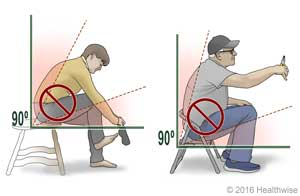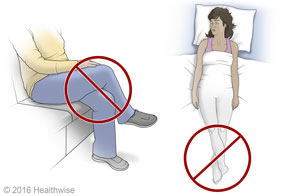Hip Replacement (Posterior) Precautions: What to Expect at Home
Your Recovery
Hip replacement surgery replaces the worn parts of your hip joint.
You will need to be careful to protect your new joint after hip
replacement surgery. Along with doing your physical therapy
exercises, there are many things you can do to help your hip heal.
Your recovery may be faster if you follow these precautions.
Try to keep your hip within the safe positions while it heals. Some
leg and foot movements may increase the risk of dislocating your
hip. Try to avoid those positions.
How can you care for yourself at home?
What are some precautions for self-care after hip replacement
surgery (posterior)?

-
Keep your toes pointing forward or slightly out. Don't rotate
your leg too far to the inside.
-
Do not bend your hip more than 90 degrees.
-
Keep your knees apart. Don't cross your legs.
Hip Replacement (Posterior) Precautions: Don't bend your hip too
far

-
Don't lean forward while you sit down or stand up, and don't
bend past 90 degrees (like the angle in a letter "L"). This
means you can't try to pick up something off the floor or bend
down to tie your shoes.
-
Don't lift your knee higher than your hip.
-
Don't sit on low chairs, beds, or toilets. You may want to use a
raised toilet seat for a while. Sit in chairs with arms.
Hip Replacement (Posterior) Precautions: Don't cross your legs

-
Imagine there's a line running down the middle of your body.
Keep your legs from crossing over it.
-
When you get into a car, back up to the seat of the car, and
then sit and slide across the seat toward the middle of the car
with your knees about 12 inches apart. A plastic bag on the seat
can help you slide in and out of the car.
-
Don't cross your legs when you sit.
-
Don't cross your ankles while lying down.
-
It may help to keep a pillow between your knees when you're in
bed.
Other tips
-
Go slowly when you climb stairs. Make sure the lights are on. Have
someone watch you, if you can. When you climb stairs:
-
Step up first with your unaffected leg. Then bring the
affected leg up to the same step. Bring your crutches or cane
up.
-
To go down stairs, reverse the order. First, put your crutches
or cane on the lower step. Then bring the affected leg down to
that step. Finally, step down with the unaffected leg.
-
You can ride in a car, but stop at least once every hour to get
out and walk around.
-
You may want to sleep on your back. Don't reach down too far to
pull up blankets when you lie in bed.
-
If your doctor recommends exercises, do them as directed. You can
cut back on your exercises if your muscles start to ache, but
don't stop doing them.
Follow-up care is a key part of your treatment and safety. Be
sure to make and go to all appointments, and call your doctor if you
are having problems. It's also a good idea to know your test results
and keep a list of the medicines you take.
When should you call for help?
 Call 911 anytime you think you may need emergency care.
For example, call if:
Call 911 anytime you think you may need emergency care.
For example, call if:
Call your doctor now or seek immediate medical care if:
Watch closely for changes in your health, and be sure to contact
your doctor if:
Current as of: July 17, 2023
Content Version: 14.0
Care instructions adapted under license by your healthcare professional. If you have questions about a medical condition or this instruction, always ask your healthcare professional. Healthwise, Incorporated disclaims any warranty or liability for your use of this information.